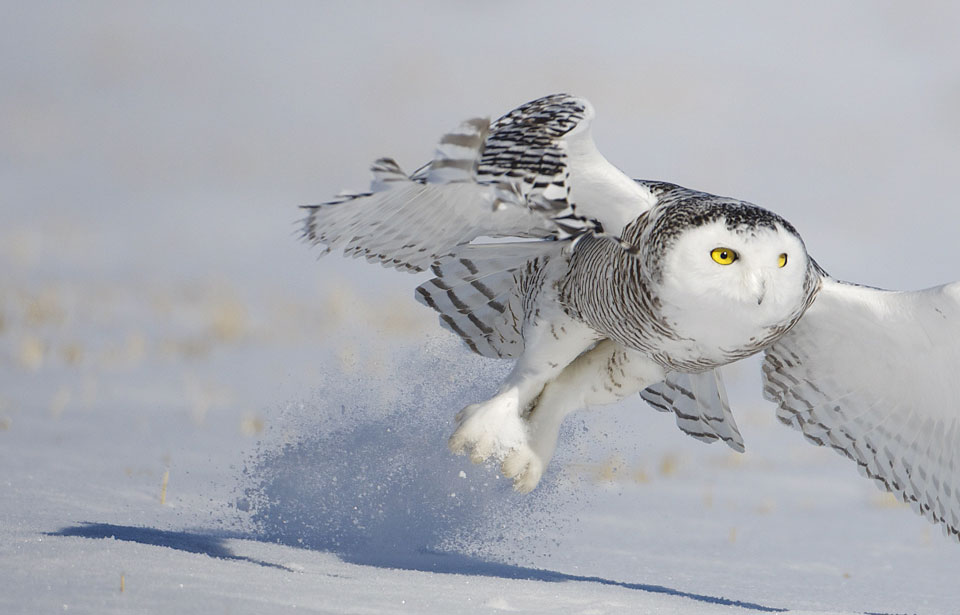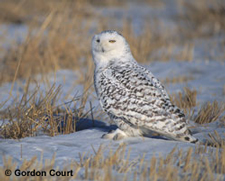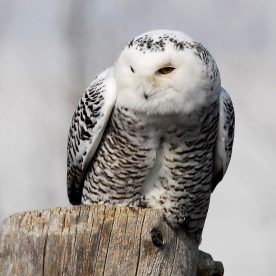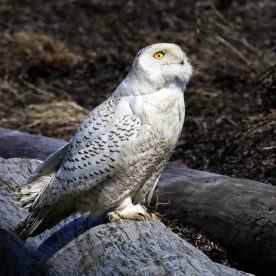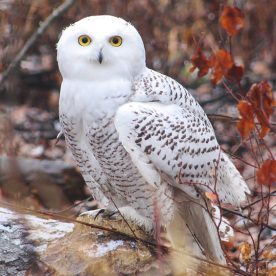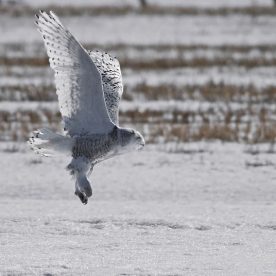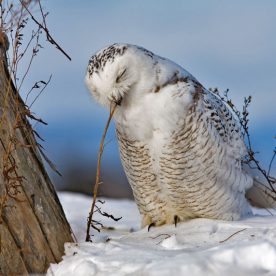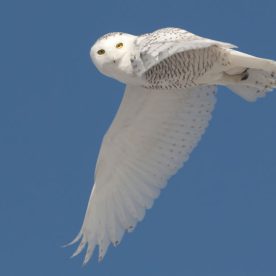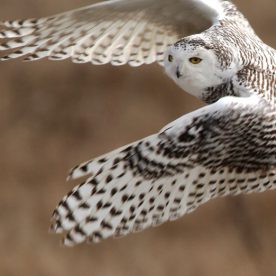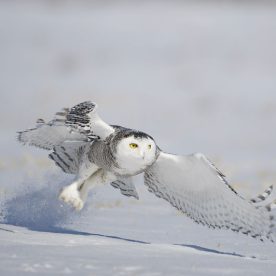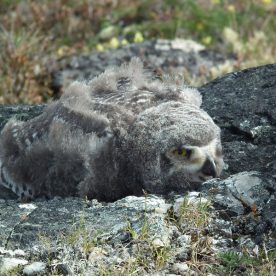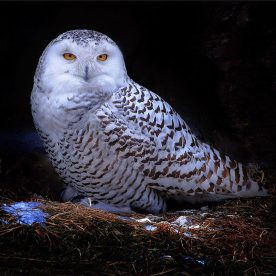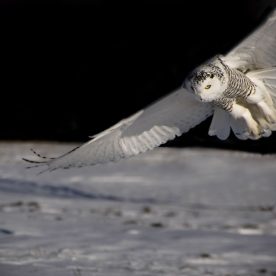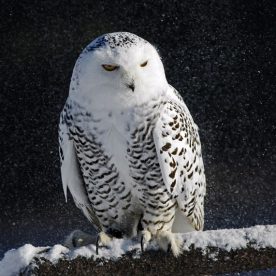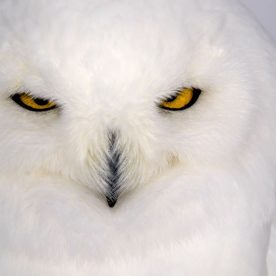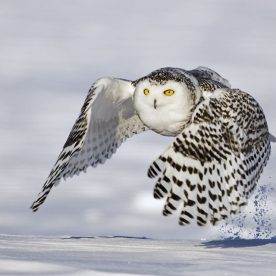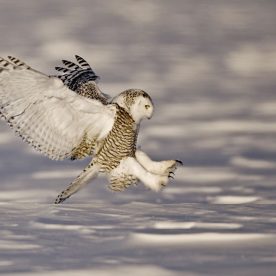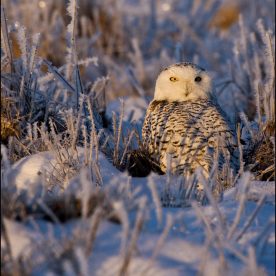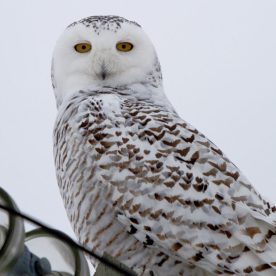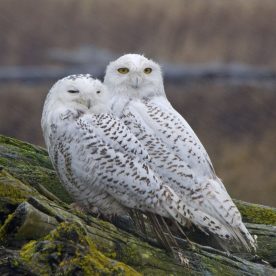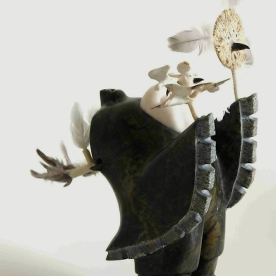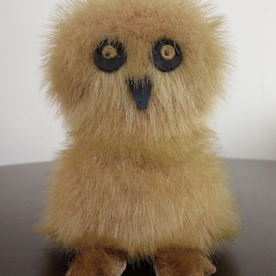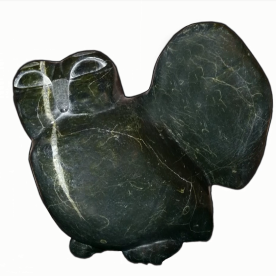Description
One of the heaviest of North American owls, the Snowy Owl Bubo scandiacus stands nearly half a metre tall, with a wingspan of almost 1.5 m. As is the case with most diurnal birds of prey—those that are active during the day—the female is larger and heavier than the male. The average weight of the female is 2.3 kg compared to 1.8 kg for the male.
Adult males may be almost pure white in colour. Adult females are darker, their white feathers barred with dark brown. First-year birds of both sexes are more darkly marked than their adult counterparts. Immature males resemble adult females, and immature females are heavily barred and may appear dark grey when seen from a distance. The light coloration of Snowy Owls provides camouflage when the owls are perched on snow, but this advantage is lost in summer. As spring approaches and the ground becomes bare, Snowy Owls move to sit on patches of snow or ice. No one knows whether they do this to camouflage themselves or whether they are merely keeping insects away or staying cool.
A dense layer of down, overlaid with thick feathering, insulates the Snowy Owl’s entire body, including the legs and toes, and enables the bird to maintain a body temperature of 38 to 40°C, even when the air temperature reaches -50°C. In strong wind, Snowy Owls may seek shelter by crouching on the ground behind a windbreak, such as a pile of stones, snowdrift, or bale of hay.
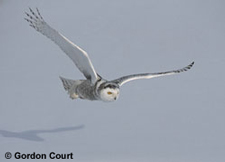
Snowy Owl in flight
The ear-like feather tufts characteristic of many species of owls are greatly reduced in Snowy Owls and are rarely visible, giving the head a typically rounded outline. The bill is black and almost hidden by surrounding feathers. The yellow eyes are surrounded by disks of stiff feathers that reflect sound waves to the ear openings located immediately behind. The Snowy Owl’s acute hearing helps the bird to detect prey in dim light, when vision is limited.
The powerful feet are equipped with curved, black claws 25 to 35 mm long, and can quickly subdue even the largest prey.
Signs and sounds
Snowy Owls are rather shy and usually silent, unless nesting. They will hiss, scream, or snap their bill at those intruding on their territories, and will dive at, or even strike, human intruders at their nests. During the breeding season, the male advertises his presence on the territory with loud hooting and will attack any intruding male.
Habitat and Habits
In the breeding season, Snowy Owls are typically found from the treeline to the northern limit of Canada, preferring high, rolling tundra with tall points of land for nest sites and perches. In the High Arctic, nests are typically situated among such upland plants as willow, saxifrage, heather, and lichens, but in the Low Arctic, Snowy Owls tend to use dense, hummocky, dwarf shrub meadow for nesting.
During winter in southern Canada, Snowy Owls inhabit prairies, marshes, open fields, or shorelines, habitats that resemble the treeless tundra of their breeding range. Although some individuals may wander in winter, many establish and defend hunting territories for periods of two or three months.
Snowy Owls spend much of their time perched on fence posts, haystacks, trees, buildings, utility poles, or other sites where the view is unrestricted. They constantly scan the area around their perches, ready to chase another owl from the territory or to launch a silent attack on a mouse or other prey.
Unique characteristics
The eyes of owls do not move in their sockets. To look to the side or to follow a moving object, the bird must swivel its head. The eyes contain many more light-gathering cells than do human eyes and can detect small objects moving at great distances. As in other owls, the visual fields of the two forward-directed eyes overlap widely. This binocular vision gives owls excellent ability to judge distances, an important attribute when attacking prey. Unlike most owls, which are nocturnal, or active only at night, the Snowy Owl is active during the day and at dawn and dusk. Because daylight is continuous within the Arctic Circle during much of the summer nesting season, this adaptation is not surprising.
In 1987, the Snowy Owl was named the official bird of Quebec.
Range
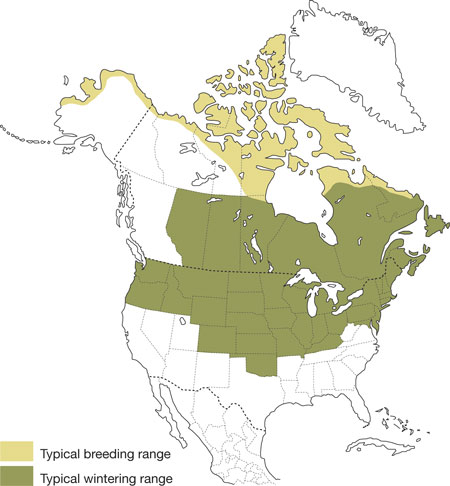
Snowy Owls breed on the arctic tundra of both Eurasia and North America. The Canadian breeding range includes the islands of the Arctic Archipelago, from Ellesmere Island in the north, to Baffin Island in the east, to Banks Island in the west, and along the northern coast of the continent from Yukon Territory to Labrador.
In winter the Snowy Owl visits many parts of southern Canada, providing most Canadians with the opportunity to observe one of the most striking and distinctive of the world’s more than 200 species of owls. Some Snowy Owls remain over the winter in the areas where they nest. Snowy Owls have been seen in midwinter as far north as 82° on Ellesmere Island, where darkness is continuous at this season. Snowy Owls also migrate to more southerly latitudes, usually beginning in November. In certain parts of their wintering range (on the prairies of western Canada and in the unforested parts of southern Ontario and Quebec, as well as in adjacent regions of the northern United States), they are regular visitors, although their numbers vary from year to year.
In other wintering areas, along the Pacific coast of Canada and the northern United States and in the Atlantic provinces and New England, their occurrence is less regular. In these regions, a winter with a large number of Snowy Owls may be followed by several years in which none are seen. It is mostly first-year birds that visit these less frequented areas, with relatively few adult owls appearing. Individual Snowy Owls have been recorded as far south as central California, Texas, and Georgia, but such records are exceptional.
It was once believed that Snowy Owl migrations were periodic, occurring regularly every three or four years, and that they matched the population lows of arctic lemmings. However, recent analyses of Christmas Bird Counts show that the numbers of Snowy Owls wintering in various parts of North America fluctuate irregularly from year to year. Some Snowy Owls may also migrate between Russia and Canada.
Feeding
Although fast enough to capture ducks on the wing, the Snowy Owl prefers small mammals as prey. In the Arctic it may eat arctic hares, ptarmigan, foxes, or seabirds when available, but lemmings are its primary prey. These rodents, resembling large meadow mice, are very heavy breeders and their populations grow rapidly, eventually outstripping the food supply. At such times, starvation, disease, and predation cause lemming numbers to dwindle rapidly until the lemmings seem on the point of vanishing. From this low, the population gradually recovers until, three or four years later, it again reaches a peak. These population fluctuations of lemmings are consistent over areas of the tundra as large as 2 500 km2, with important consequences for the breeding biology of Snowy Owls in these areas.
On their winter range, Snowy Owls also feed mainly on small rodents, usually meadow voles and white-footed or deer mice. Snowy Owls that winter near grain elevators or garbage dumps may feed almost exclusively on rats. However, Snowy Owls will hunt for what is available and will feed on mammals ranging in size from shrews to jackrabbits and on birds ranging from sparrows to ducks and pheasants.
Prey are usually captured at the end of a short flight from a perch, although Snowy Owls also hunt on the wing, especially on the flat arctic tundra, flying slowly 10 to 15 m above the ground, ready to drop on any prey.
Snowy Owls, like other birds of prey, swallow small prey items whole. Strong stomach juices digest the flesh, and then the indigestible bones, teeth, fur, and feathers are compacted into oval pellets that the bird regurgitates, or brings up, 18 to 24 hours after feeding. Regurgitation often takes place at regular perches where dozens of pellets may be found. Biologists frequently examine these pellets to determine the quantity and types of prey eaten. In southern Canada, the pellets most commonly contain the fur and bones of meadow voles and other mice. Each Snowy Owl must capture the equivalent of 7 to 12 mice a day to meet its food requirements.
Breeding
Snowy Owls that winter in southern Canada and the northern United States begin moving northward to their arctic breeding grounds in February and March. Snowy Owls sometimes gather in pairs or small groups at this time, and occasionally as many as 20 Snowy Owls may be seen perched within a few hundred metres of one another. Most are gone from their wintering range by April.
Migrating Snowy Owls return to their breeding grounds while the tundra is still snow-covered. Each pair occupies a breeding territory of 1 to 2 km2 in area. Courtship begins in early May. The male performs display flights with exaggerated wing beats, as well as ground displays in which he stands erect in front of the female with his wings partially spread. Often a male will carry a dead lemming in his bill during these displays.
The nest is merely a shallow depression scraped in the ground by the female, containing a few of her feathers and perhaps a few species of grass or moss. Nests are located on knolls, ridges, or other prominent locations. These are the only snow-free sites available when nesting begins and provide commanding views of the surrounding areas.
The breeding of Snowy Owls is intimately related to fluctuations in lemming populations in regions where the owls depend on this food supply. When lemmings are plentiful, Snowy Owls respond by laying large clutches, or sets of eggs, containing as many as 11 or 12 eggs. When lemmings are less numerous, the clutch size is four to seven eggs. When a local lemming population crashes, Snowy Owls may not nest at all or they may move 50 to 100 km and breed in another area where lemmings are available.
Only the female incubates, or warms, the eggs and broods the newly hatched young, sheltering them by sitting on them. Because temperatures are usually below freezing during the early stages of the nesting cycle she must perform these duties almost continuously. During this period the male feeds his mate, capturing lemmings and delivering them to her at the nest. He also provides most of the food for the chicks during their first weeks of life.
One egg is usually laid every second day until the clutch is complete, but incubation begins with the laying of the first egg. Consequently, following an incubation period of 32 to 34 days, chicks hatch, usually in July, at intervals of approximately 48 hours. Therefore, broods contain chicks that range widely in age and size. Although staggered hatching results from the need to begin incubation with laying of the first egg, it also permits adjustment of brood size to the food supply. If the adults are unable to provide sufficient food for all their chicks, the younger, smaller chicks are unable to compete with their larger nest-mates, and soon starve.
Newly hatched chicks are covered with white down, but they rapidly grow an additional, dark grey coat of down, so that they appear nearly black at 10 days of age. Chicks leave the nest when only three to four weeks old, long before they can fly. They scatter widely around the nest but are faithfully fed by their parents. The young have huge appetites, and the parents of a brood of nine chicks must provide about 120 kg of food, or nearly 1 500 fully grown lemmings, before their young become independent. Fledging, or first flight, occurs at seven to eight weeks of age, by which time the dark down has been replaced by immature plumage. By this time the short arctic summer is almost over, and the young birds must soon undertake their first migration.
Conservation
Snowy Owls have few natural predators. During the nesting season, unattended eggs and chicks may be subject to predation by jaegers—swift-flying, predatory relatives of gulls—or by arctic foxes. However, the adults are vigilant and well equipped to defend against these threats.
Although exposed to severe environmental conditions in both summer and winter, Snowy Owls are superbly adapted to cope with these challenges. Food shortage may be a danger, but their mobility permits Snowy Owls to move to areas where supplies are sufficient. Although starvation may kill some immature, inexperienced birds that wander beyond the normal winter range, human activities probably pose the greatest danger to birds that spend the non-breeding season in settled regions. Collisions of flying birds with power lines, wire fences, automobiles, or other structures are an important cause of mortality among Snowy Owls wintering in southern Canada. At one time, hunters shot Snowy Owls during their movements from the Arctic. While some Snowy Owls are still shot illegally in winter, most people are satisfied to enjoy the sight of these spectacular and mysterious birds, or to shoot them with cameras rather than guns.
Provincial and territorial regulations prohibit the killing of these birds in all parts of Canada. Banding for scientific purposes—tracking birds by placing numbered aluminum bands on their legs—requires special federal and provincial permits. Environment Canada supports arctic ecology projects that include the study of Snowy owls. For example, work on Bylot Island, Nunavut, has examined the interactions between Snowy Owls, Snow Geese, arctic foxes, and lemmings, and has shown how geese benefit by nesting close to Snowy Owls because the owls provide protection from other predators, like foxes. Environment Canada has also supported studies of the biology of Snowy Owls in winter.
This species is an important component of the food web in the tundra ecosystem and a fine example of complex physical and behavioural adaptations to the extreme conditions of this environment. During its visits to the south, the Snowy Owl may play a useful role in the natural control of rodents in agricultural regions.
Resources
Online resources
Audubon Field Guide. Snowy Owl
Print resources
Parmelee, David. 1992. Snowy Owl. In The Birds of North America, no. 10. A. Poole, P. Stettenheim, and F. Gill, editors. The Academy of Natural Sciences, Philadelphia; The American Ornithologists’ Union, Washington, D.C.
© Her Majesty the Queen in Right of Canada, represented by the Minister of Environment, 1974, 1979, 1980, 1991, 2007. All rights reserved.
Text: Ronald D. Weir
Revision: M. Ross Lein, 1989; Mark Mallory, 2006
Photos: Gordon Court
Print Version
Catalogue number CW69-4/46-2006E
ISBN 0-662-43307-6
PDF version
Catalogue number CW69-4/46-2006E-PDF
ISBN 978-0-662-47037-3



